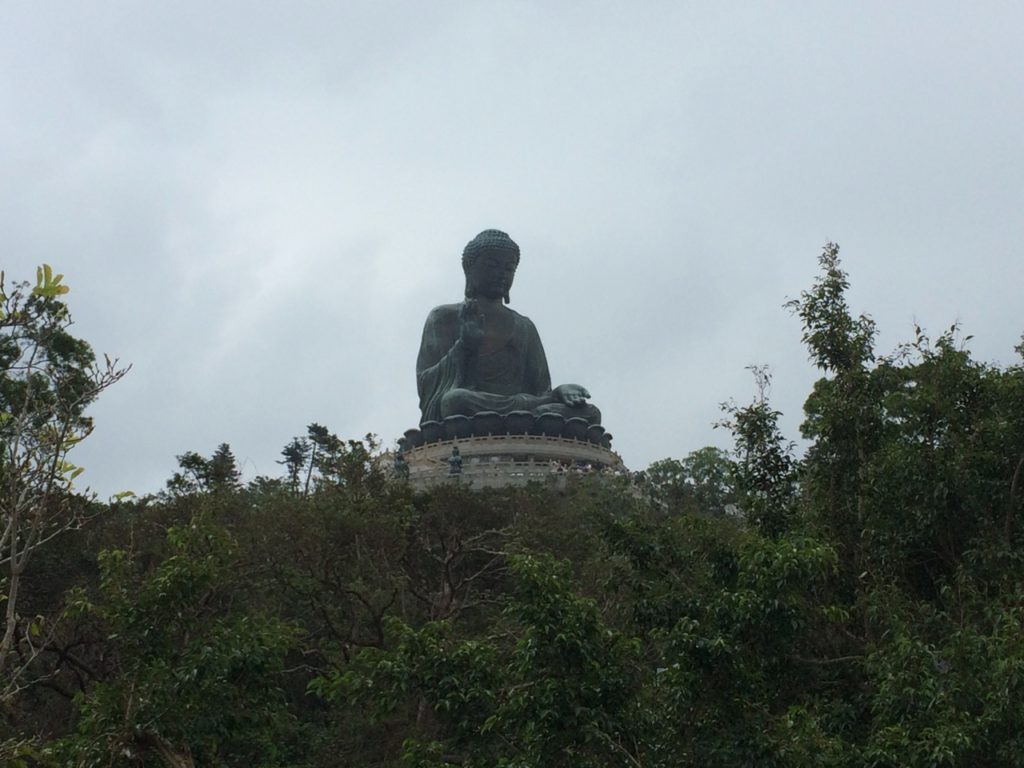Hong Kong is the most heavily urbanized place I’ve ever been, and I’m not sure what exactly it is that I mean by that.
Yeah, there are skyscrapers everywhere–353 at least count, a full hundred more than the next most-heavily skyscrapered city in the world, New York. And people… loads of people, 7 million of them jammed into a deceptively large 427 square miles, a ratio that puts the city as the fourth densest in the world. And it is deceptive, because many of those square miles are taken up with unbuildable sheer hillsides (although, Lord knows, they’ve done their best to challenge the meaning of the word “unbuildable”) or vast preserved parklands, havens of green in the gray concrete jungle that must be all that keep the citizenry from sinking into bleak dystopian madness.
But it’s more than just a lot of people or a bunch of really tall buildings. It’s the sense, maybe, that there’s nothing beyond that, that a lifestyle incorporating any kind of escape to suburban or rural outlets is unavailable. As it always has been for Hong Kong… a territory of islands and hills, then a British colony held separate from the mainland after the Opium Wars, and now a Special Administrative Region of the People’s Republic of China, a stew of East and West that has proven so tasty to modern enterprise that even the new Communist landlords fear adding ingredients to sour the taste.
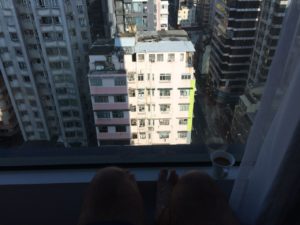
So you wander canyons of concrete and steel and then find yourself looking into a major sports stadium nestled into the middle of the financial district, or watch kids filing in and out of ten-story elementary schools. Humanity, the regular things that people do, is totally adapted to city living.
And it’s small city living. Everyone is on top of each other in some of the most cramped, most expensive real estate in the world. The average Hong Kong resident has about 160 square feet to call home. That’s approaching boat-living standards, so it doesn’t seem utterly outlandish to me, but writ large, it trickles out into a lifestyle that is profoundly different from anything I am used to. The laundry flying from every window wouldn’t be out of place in a marina, but to see it lining every block of a 7-million person megalopolis is utterly foreign.
Our hotel was in the so-called New Territories, in Kowloon on the mainland side. New is a relative term, though; most of the buildings and neighborhoods were older than what we saw on Hong Kong side. It’s a cheaper, denser area with fewer Westerners around; I was often the only white face on the street.
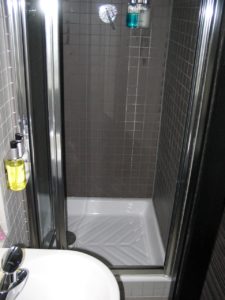
It was, predictably, a pretty tiny accommodation… basically the same footprint as the bed with a narrow walkway around it. Big windows made it feel open, though, and the bathroom was a compact but useable scale compared to some places I’ve been.
The windows were the finest feature, however. In residential blocks 30 stories high, on every side, humanity was on full display. Laundry flapping from complex and inventive apparatus reaching from every window, old people doing tai chai on rooftops, a yoga class on the terrace below (complimentary with the hotel stay!), bakers stocking their wares in shops, businessmen hurrying to work… it’s all happening in Hong Kong, any time you feel like looking out the window.
The first day I was feeling human again after the flight from Vancouver (in other words, the second day of the trip), we decided to grab a ferry across the harbour to visit the Alexander Grantham, an old fireboat that has been turned into a museum.
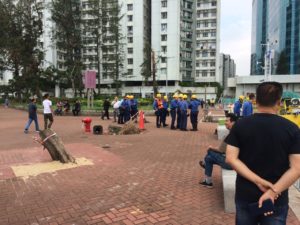
As we arrived at the Hung Hom ferry landing, we got to see a new fireboat up close. Sirens echoed through the canyons of skyscrapers and slowly converged on the ferry landing as various apparatus pulled up and began disgorging firefighters wearing life vests and helmets. A dive boat was pulled up next to the pier awaiting them, but whether it was a drill or an actual emergency that was called off, they never boarded and the boat was still sitting there when we pulled away on the ferry.
Like pretty much every other mode of transport in Hong Kong, you can pay for the ferry with an Octopus card. The penetration of the transit card is so broad that you can conduct just about every other sort of commerce in the city with it as well, from 7/11 to vending machines to supermarkets. As a tourist, you almost don’t need any cash at all to navigate the city.
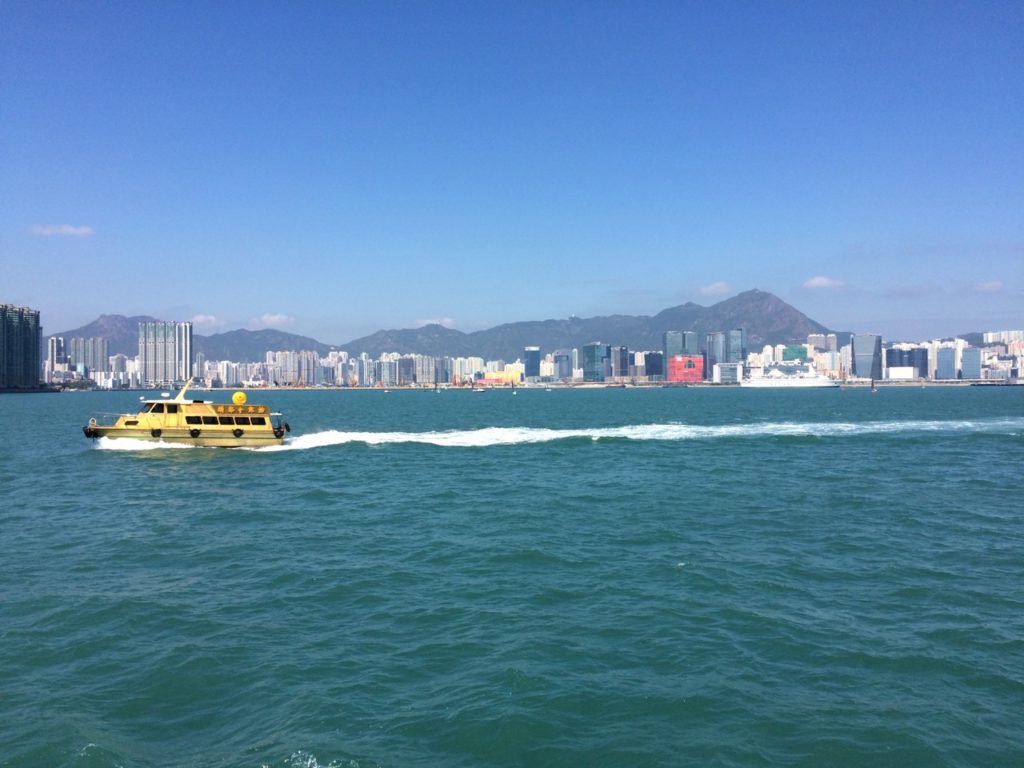
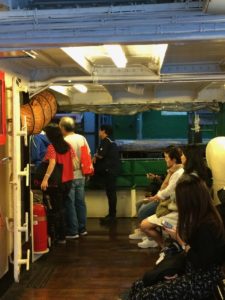
As advertised, the ubiquitous ferries offer some of the best views of the city from the water. You don’t even need to take a special sightseeing cruise. Adding to the tourist-attraction aspect, the staff wear some adorable little sailor uniforms.
The Grantham is high and dry these days in a permanent exhibition along the waterfront walkway at Quarry Bay. It’s an easy walk from North Point or even easier MTR ride to Tai Koo station. In the park around the boat are exhibits detailing the history of firefighting throughout the harbor and the buildout and operations of the boat. It was moderately interesting but what really grabbed my attention was the first marine squat head I have ever seen:
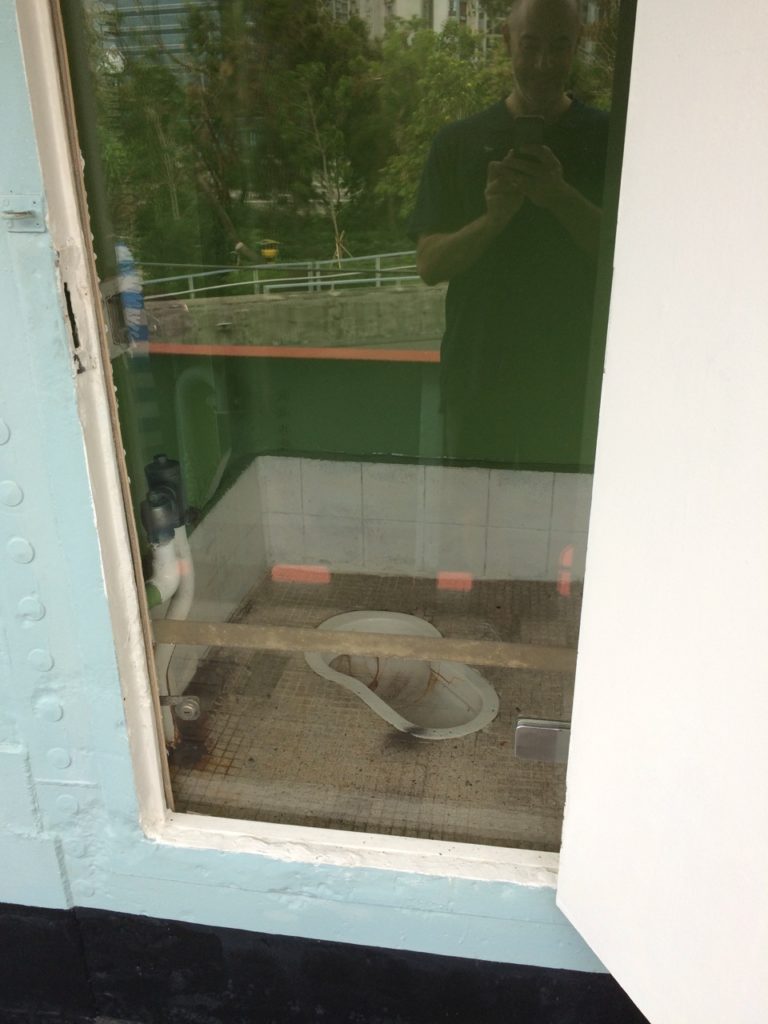
From the Grantham, we took the so-called ding ding tram back west through the city. It was quite crowded with locals and tourists alike but provided an intimate and easy tour of the city, fresh perspectives on daily life at every stop. We passed skyscrapers with windows blown out by the recent typhoon, bamboo scaffolding going up for the workers to repair them; banks and investing businesses; elementary schools and wet markets; stadiums and shops, both at the high end of Western brands and hole-in-the-wall local apothecaries.
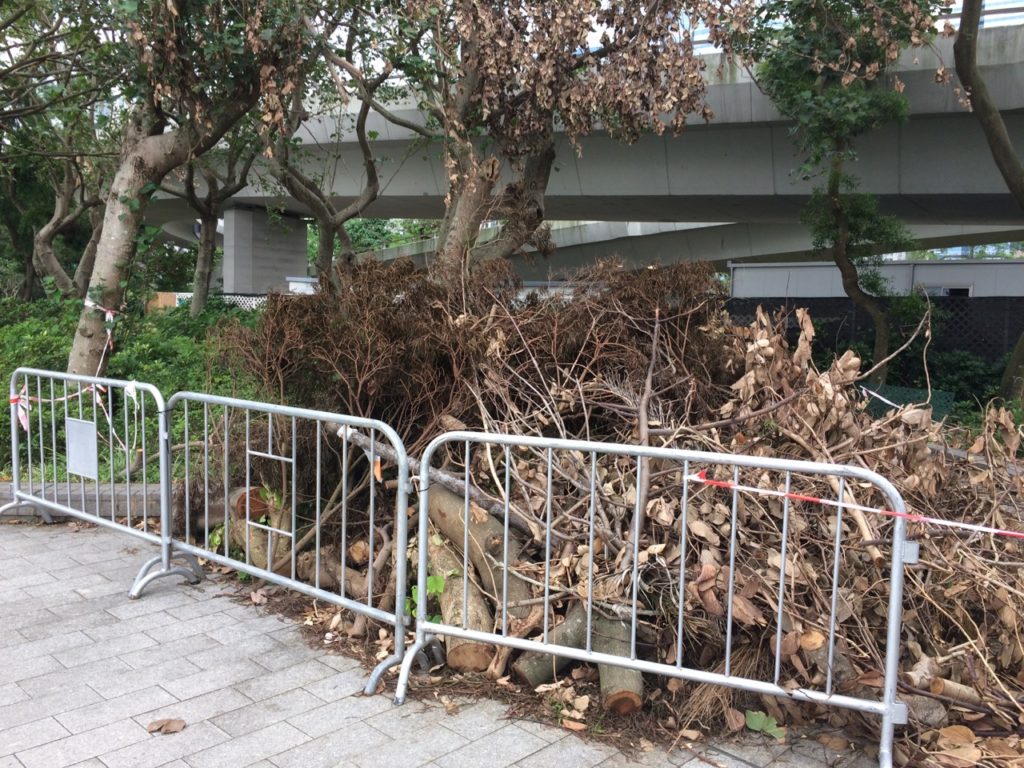
I was pretty tired long before sunset but managed to stay awake long enough for the nightly light and sound show that lights up many of the skyscrapers on both sides of the harbour. It’s only ten minutes and a little underwhelming, considering what they have to work with. But judging by the crowds along the waterfront, it’s a pretty popular event.
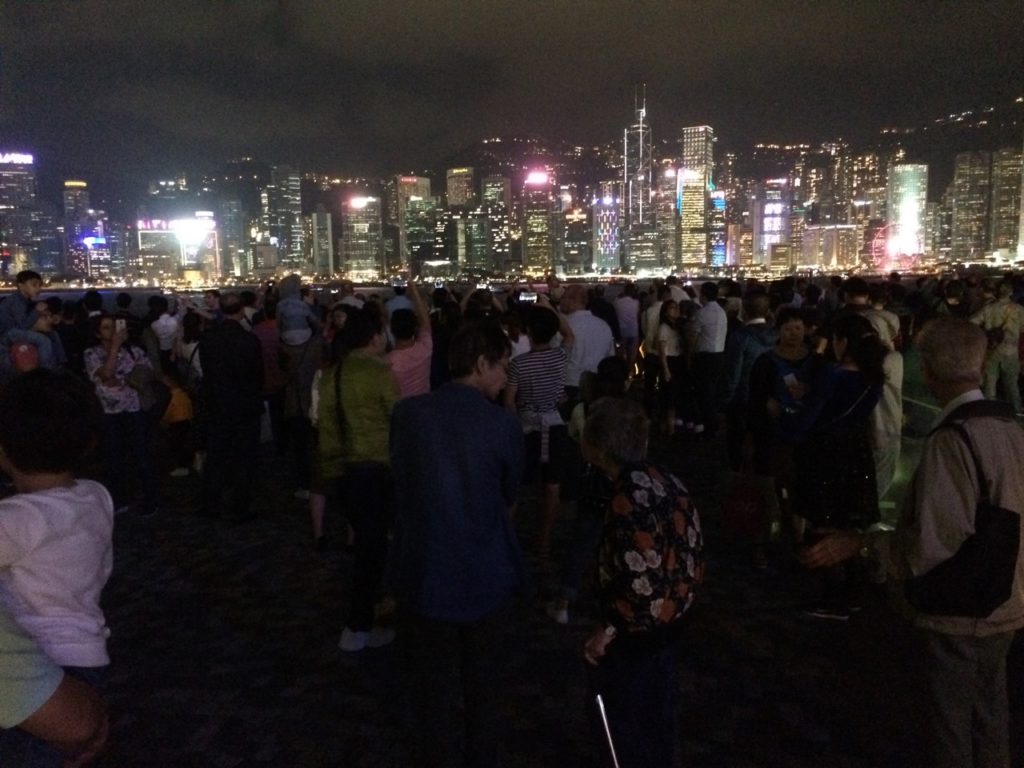
By the next day I was feeling a little more ambitious, so we took the MTR back out to Lantau Island, where the airport is located, to trek to the Big Buddha overlooking the Po Lin Monastery.
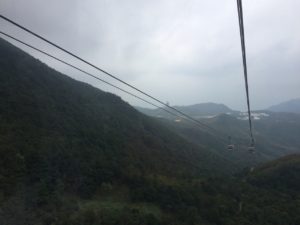 You can, and possibly should, actually hike up to the mountain monastery. But what we did was take the cable car that runs over the hiking trail for much of the route. The day was misty and the views were limited, although I could barely make out, off in the distance, the great maw in the Zhujiang River Estuary swallowing the brand new six-lane Hong Kong-Zhuhai-Macau 4-mile long tunnel leading to the invisible 14 mile viaduct to the mainland.
You can, and possibly should, actually hike up to the mountain monastery. But what we did was take the cable car that runs over the hiking trail for much of the route. The day was misty and the views were limited, although I could barely make out, off in the distance, the great maw in the Zhujiang River Estuary swallowing the brand new six-lane Hong Kong-Zhuhai-Macau 4-mile long tunnel leading to the invisible 14 mile viaduct to the mainland.
We could see pretty clearly the more robust hikers on the trail beneath us, taking the hard way to the top.
The walk might actually have been faster than the cable car, though, considering how long you have to stand in line–first, to get the tickets, then, to board the car. It must have taken close to two hours before we worked our way up to the head of the line and actually got on.
The ride proved not to be worth either the wait or the cost, although it might have been better on a clear day.
Getting up to the Buddha, once you arrive at the tiny village near the monastery complex (and I say “village” but don’t let it conjure up idyllic pictures of natives going about their daily lives as they and their forebears have done for hundreds of years… it’s basically just a row of shops designed to capture as many tourist dollars as possible) is absolutely free, however. With a little bit of a climb involved. If I had hiked up the mountain, I might have quit at the last set of stairs up to the Buddha. But, feeling fresh, and refreshed after a stop at the 7/11 in the “village,” we made short work of the stairs, and some other walking paths around the area.
It was all right, for a tourist trap, but I enjoyed the Chi Lin Nunnery and Nan Lian Gardens, a set of attractions slightly further off the beaten path, more. We took the bus and enjoyed the tranquil setting of the monastery courtyard and gardens under the watch of the ubiquitous towering skyscrapers and hills.
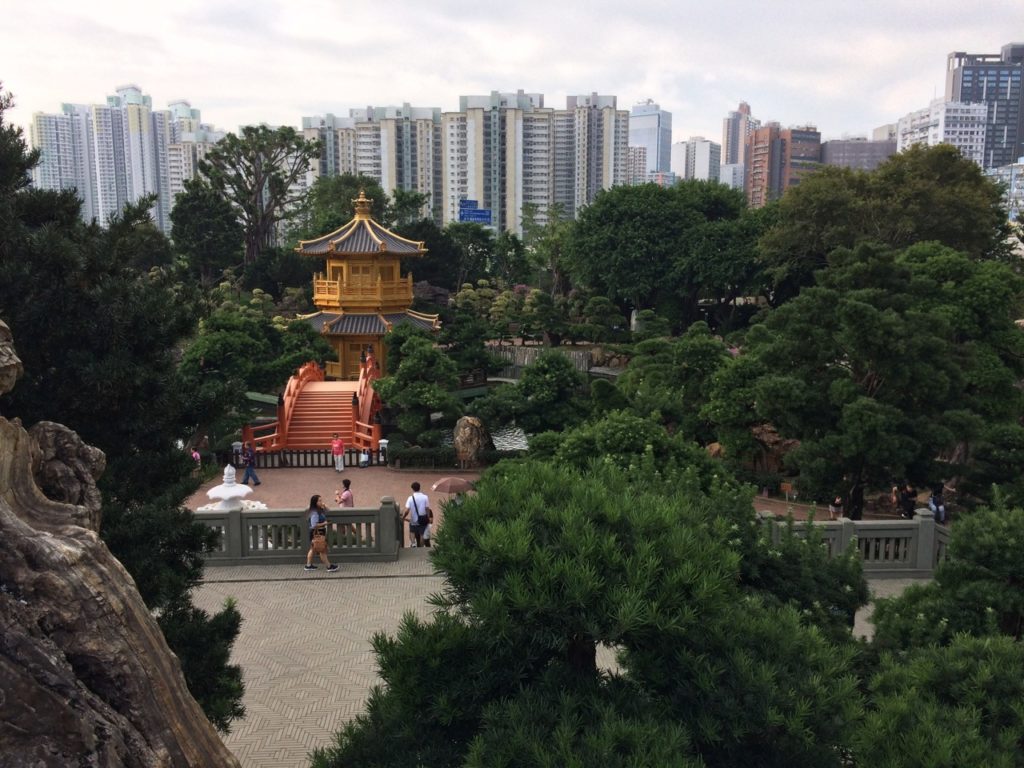
Monica had a local restaurant that she wanted to try and there happened to be a branch of it near the monastery, so we decided to walk to it for lunch. The weather was very mild and walking was pleasant, at least in comparison to Bangkok this time of year.
It was also an interesting opportunity to get a ground-level view of a very local neighborhood. The place is near the site of the former Kai Tak international airport, which closed in 1998 (the mountainous surroundings and runway extending into the bay made the place famously difficult to land at and resulted in many accidents). The area, then, was primarily an industrial one until quite recently, and retains much of that flavor (although, inevitably, the site is being redeveloped as residential and tourist properties now). We walked past produce warehouses and garages, a printing factory, and a university.
The restaurant turned out to not be that good, although the people watching was terrific. Like a lot of places in Asia, you often end up sharing a table with other random customers; our table mates appeared to be a couple of engineers on lunch break, and their English was good enough that they kindly helped us translate some of our order for the waitress.
All told, I found Hong Kong fascinating and will definitely be back again to check out the many facets of the place that I missed in this brief visit.


